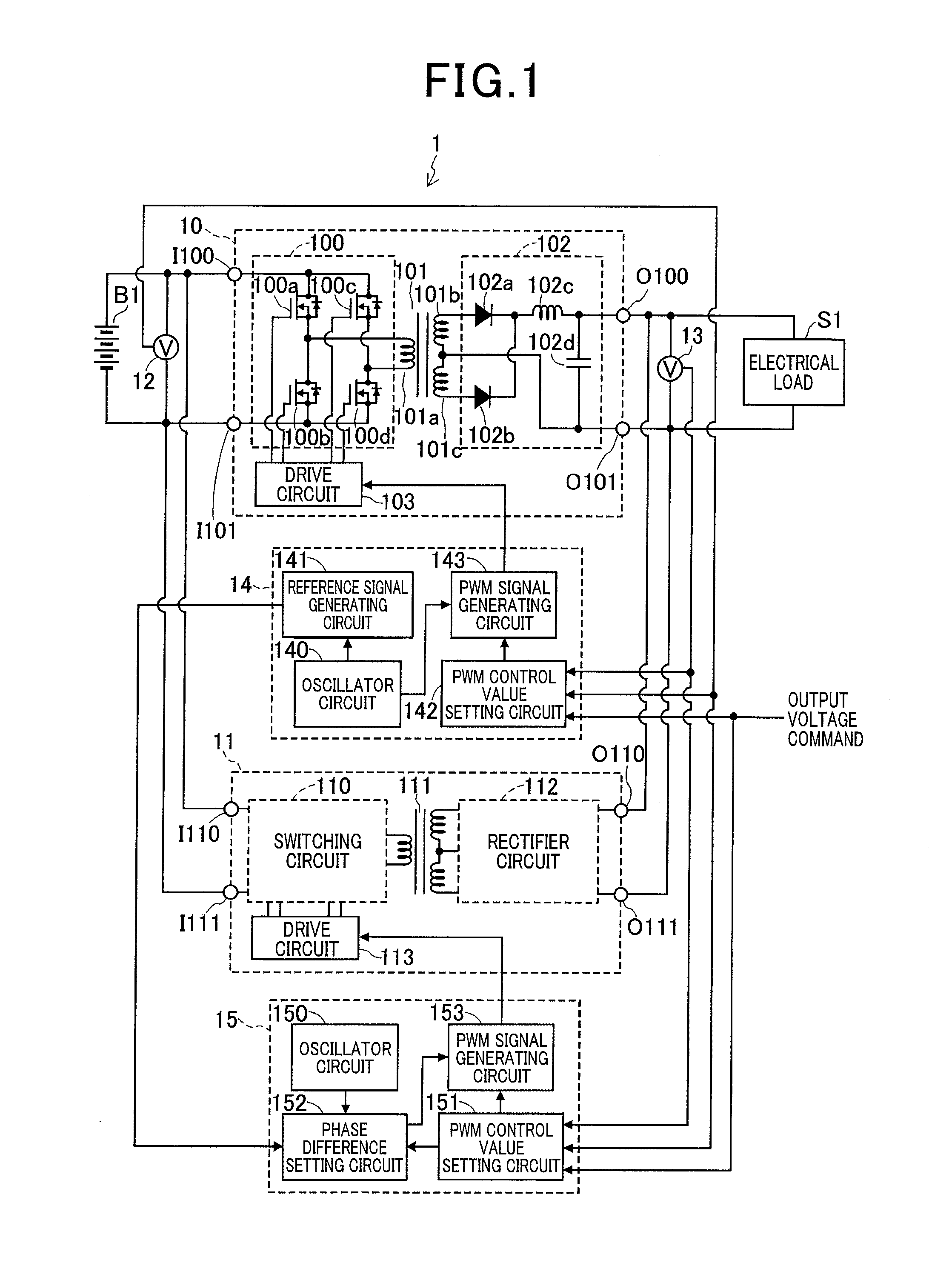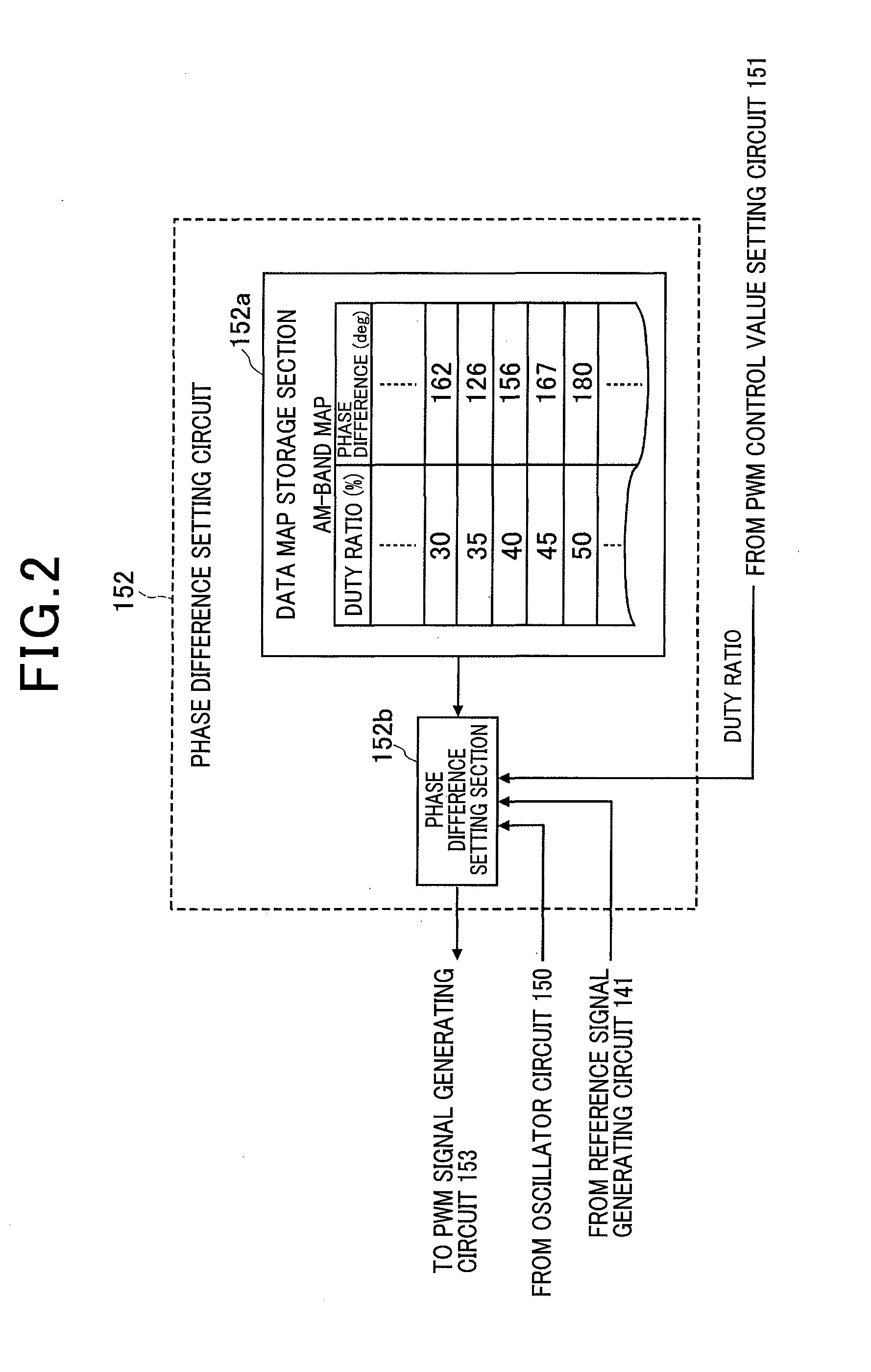Electric power converter apparatus which attenuates frequency components of ripple in output current
a technology of ripple current and power converter, which is applied in the direction of power conversion systems, dc-dc conversion, instruments, etc., can solve the problems of substantial electrical noise produced by output current and interference with radio reception, and achieve the effect of reducing interference and reducing ripple current frequency components
- Summary
- Abstract
- Description
- Claims
- Application Information
AI Technical Summary
Benefits of technology
Problems solved by technology
Method used
Image
Examples
first embodiment
[0035]A first embodiment will be described referring to FIG. 1. As shown, an electric power converter apparatus 1 of this embodiment receives DC power from a high-voltage battery B1 of a vehicle, and converts this to output DC power which is supplied to an electrical load S1 of the vehicle. The electric power converter apparatus 1 includes two electric power converter circuits 10 and 11, voltage sensors 12 and 13, and two control circuits 13 and 14.
[0036]The electric power converter circuit 10 converts the input DC power, supplied from the high-voltage battery B1, to output DC power that is supplied to the electrical load S1, at a different voltage from that of the input DC power, with the output DC power electrically insulated from the input DC power. As shown, the electric power converter circuit 10 includes a switching circuit 100, a transformer 101, a rectifier circuit 102 and a drive circuit 103.
[0037]The switching circuit 100 converts the DC power from the high-voltage battery...
second embodiment
[0083]A second embodiment of an electric power converter apparatus is described in the following. This embodiment utilizes a data map as for the first embodiment, but differs from the first embodiment in that the phase difference values stored in the data map can be corrected during operation of the apparatus, as described in the following.
[0084]The electric power converter apparatus 2 of the second embodiment will be described referring to FIGS. 9 and 10. As shown in FIG. 9, the overall configuration is similar to the electric power converter apparatus 1 of the first embodiment, with DC power from a high-voltage battery B2 of a vehicle being converted to an DC power at a different voltage, and supplied to an electrical load S2 of the vehicle.
[0085]Electric power converter circuits 20 and 21 of this embodiment are identical to the circuits 10 and 11 respectively of the first embodiment. The voltage sensors 22 and 23 of the second embodiment are of identical type to the sensors 12 an...
third embodiment
[0099]A third embodiment is described in the following. The electric power converter apparatus 3 of this embodiment utilizes a pair of data maps, respectively corresponding to AM-band and FM-band frequency ranges as described in the following, but is otherwise similar to the second embodiment described above.
[0100]The configuration of the third embodiment will first be described referring to FIGS. 11 and 12. Only the features of difference from the second embodiment will be described in detail. As shown in FIG. 11, the electric power converter apparatus 3 of the third embodiment incorporates a control circuit 35, which includes an oscillator circuit 350, a PWM control value setting circuit 351 and a PWM signal generating circuit 353 that are respectively identical to the oscillator circuit 250, the PWM control value setting circuit 251 and the PWM signal generating circuit 253 in the control circuit 25 of the second embodiment. The control circuit 35 further includes a phase differe...
PUM
 Login to View More
Login to View More Abstract
Description
Claims
Application Information
 Login to View More
Login to View More - R&D
- Intellectual Property
- Life Sciences
- Materials
- Tech Scout
- Unparalleled Data Quality
- Higher Quality Content
- 60% Fewer Hallucinations
Browse by: Latest US Patents, China's latest patents, Technical Efficacy Thesaurus, Application Domain, Technology Topic, Popular Technical Reports.
© 2025 PatSnap. All rights reserved.Legal|Privacy policy|Modern Slavery Act Transparency Statement|Sitemap|About US| Contact US: help@patsnap.com



